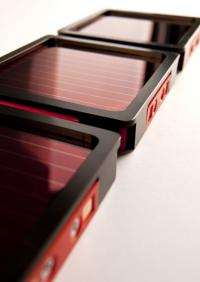Innovative organic solar cell architecture sets new performance level

The Belgian research centre imec, together with Plextronics and Solvay, present this week at the European Photovoltaic Solar Energy Conference and Exhibition (PVSEC) in Hamburg an organic polymer-based single junction solar cell with 6.9% performance in an innovative inverted device stack.
Combining imec’s scalable inverted device architecture and Plextronics’ polymers, new levels of cell efficiency were achieved. The polymer was also integrated into a module resulting in excellent module level efficiencies of 5% for an aperture area of 25cm2.
Organic solar cells are regarded as an emerging technology to become one of the low-cost thin-film alternatives to the current dominating silicon photovoltaic technology, due to their intrinsic potential for low-cost processing (high-speed and at low temperature). Inverted architectures are developed to extend the lifetime of organic solar cells, an investigation which is currently ongoing for this new architecture. By combining architecture improvements with optimizations to the active layer using different types of polymers, imec aims at making the organic photovoltaic technology ready for market introduction.
The dedicated inverted bulk heterojunction architecture developed by imec improved the device performance by at least 0.5% over standard architectures used for organic solar cells. In the active layer, a new buffer layer was introduced to optimize the light management in the device. Imec’s innovative device architecture, combined with Plextronics’ low band-gap p-type polymer with a fullerene derivate, resulted in a stabilized certified conversion efficiency of 6.9%, which is the highest performance obtained for this polymer material and, to our knowledge, the highest efficiency reported for inverted architectures. In this new inverted device architecture, similar performance boosts have also been achieved for other polymer materials. The module level efficiencies confirm the suitability towards upscaling.
Tom Aernouts, R&D Team Leader Organic Photovoltaics at imec: “We are delighted to present these excellent results, achieved by combining imec’s expertise and knowhow in organic photovoltaics R&D with Plextronics’ innovative material. With further optimizations to the material as well as to the architecture, for example by introducing a multi-junction featuring different layers of different polymers each capturing another part of the light spectrum, we envision organic solar cell lifetimes of over 10 years and conversion efficiencies of 10% in two to three years, ultimately aiming at industry-relevant solutions.”
Provided by IMEC





















